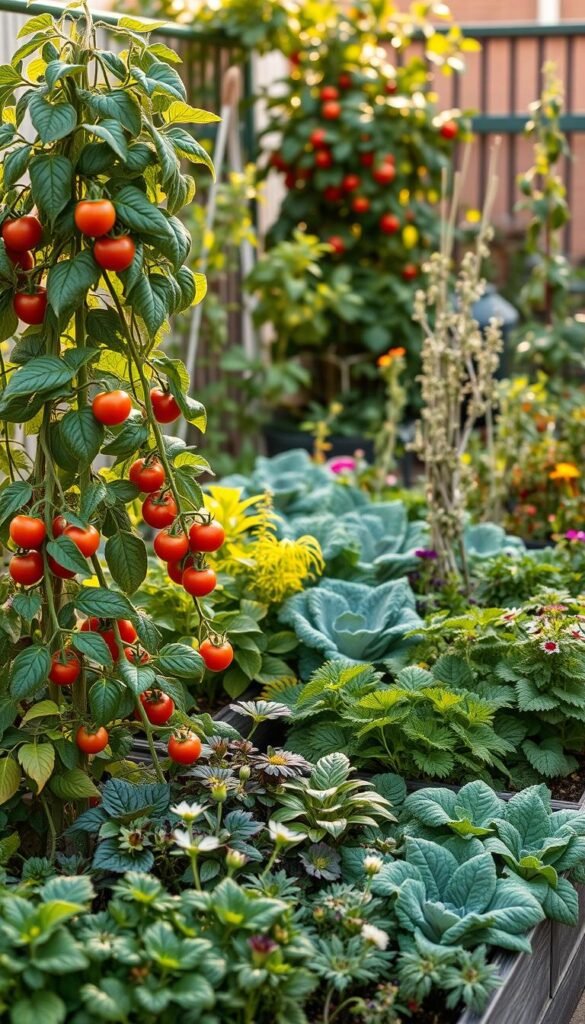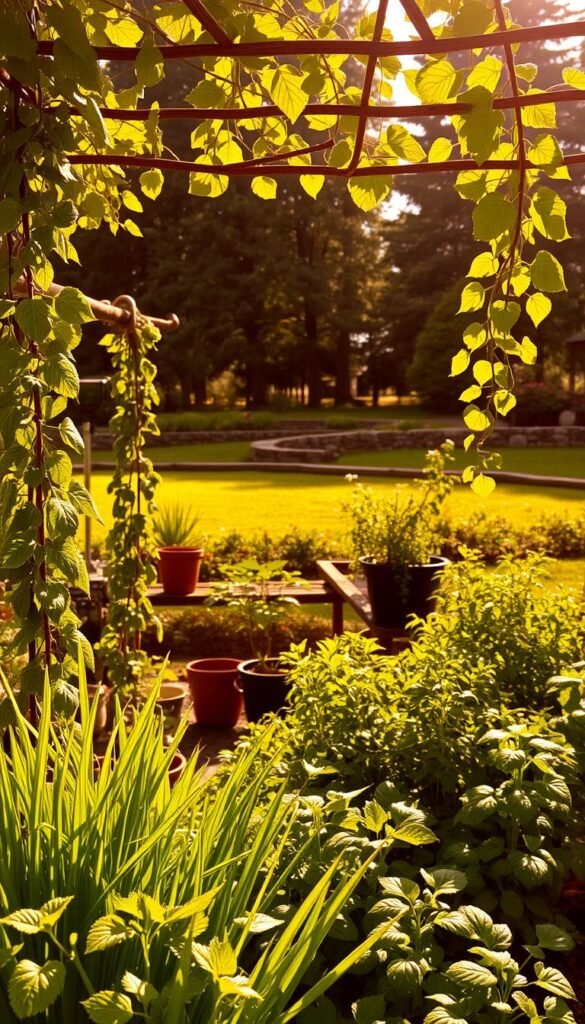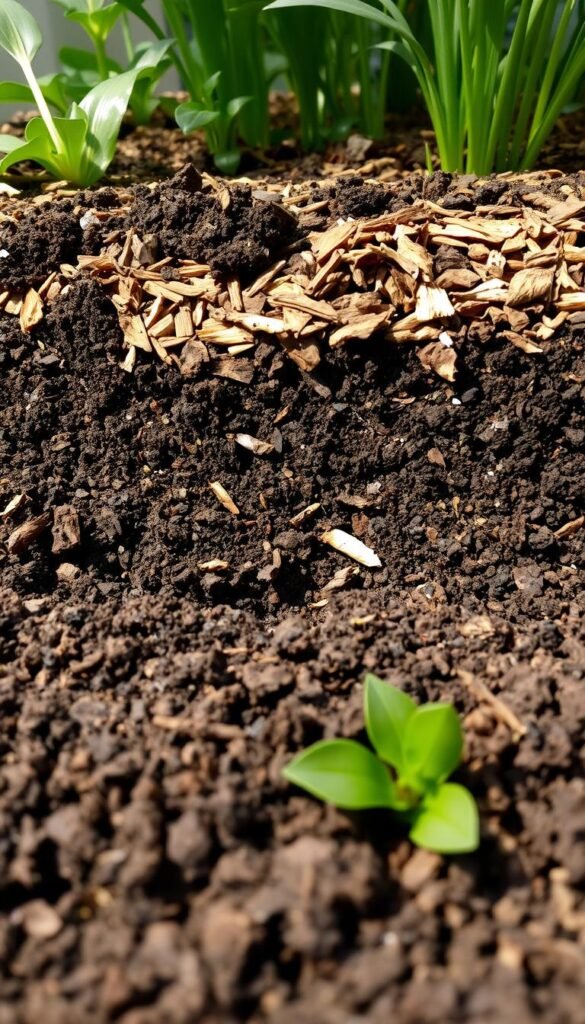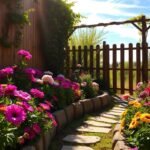Think your outdoor area is too tiny for a thriving green oasis? Think again! With clever strategies, even a balcony or patio can burst with fresh herbs, juicy tomatoes, or vibrant blooms. This guide shows you how to transform cramped corners into productive plots.
Success starts with smart planning. Measure your available spots and note sunlight patterns. Use vertical surfaces like walls for hanging planters – they add depth without eating floor space. Window boxes turn overlooked ledges into strawberry havens or basil factories.
Container choices make all the difference. Try stackable pots for herbs or dwarf fruit trees in whiskey barrels. Repurposed items like old ladders become instant plant displays. We’ll share expert-approved methods to help you select crops that thrive in cozy conditions.
Key Takeaways
- Strategic layouts turn awkward areas into productive growing zones
- Vertical surfaces and containers dramatically increase planting capacity
- Proper plant selection ensures success in limited-square-footage setups
- Creative repurposing gives new life to everyday household items
- Beginners and experts alike can achieve satisfying results
- Sunlight mapping prevents wasted effort on incompatible crops
Understanding Your Garden Space
Unlock your garden’s hidden potential by first studying its unique features. Start with a simple walk-through at different times of day—this reveals patterns you’d otherwise miss.
Assessing Your Space and Sunlight
Grab a notebook and track how light moves across your area. Mark spots that get 6+ hours of direct sun versus shaded corners. Use free apps like Sun Seeker to pinpoint exact exposure levels.
Measure every surface—windowsills, railings, and vertical walls count. Narrow ledges can host shallow-rooted herbs, while sturdy fences become cucumber trellises. Pro tip: South-facing zones often work best for sun-loving veggies.
| Sunlight Zone | Best Plant Types | Placement Tips |
|---|---|---|
| Full Sun (6+ hours) | Tomatoes, peppers, rosemary | Use elevated containers near walls |
| Partial Shade | Lettuce, mint, kale | Group in mobile planters |
| Full Shade | Ferns, hostas, begonias | Utilize under-deck spaces |
Mapping Your Available Areas
Sketch your layout using grid paper or digital tools like Garden Planner. Highlight overlooked areas—the space above garage doors or between pavers. Color-code zones by sunlight intensity to visualize planting options.
Note problem spots like wind tunnels or poor drainage. Adjust your plan early: swap moisture-loving plants for drought-tolerant varieties in dry zones. Remember, even a 2-foot balcony can yield salad greens year-round with smart mapping.
Choosing the Right Plants for Small Spaces
Your cozy garden’s success starts with selecting space-savvy varieties. Focus on crops that deliver big flavors without sprawling growth. Dwarf fruit trees and clustered herbs prove you don’t need acres to enjoy fresh harvests.

Selecting Compact, High-Yield Varieties
Look for terms like “patio” or “bush” when picking vegetable seeds. Cherry tomatoes thrive in hanging baskets, while dwarf kale fits window boxes perfectly. These champions produce abundant crops in tight quarters.
| Plant Type | Container Size | Yield Per Season |
|---|---|---|
| Bush Cucumbers | 5-gallon pot | 8-12 fruits |
| Patio Peppers | 3-gallon container | 15-20 peppers |
| Mini Basil | 6-inch pot | 4 cups chopped |
The Power of Companion Planting
Pairing certain plants creates natural partnerships. Herbs like basil boost tomato growth while repelling pests. Try these dynamic duos:
Marigolds protect vegetable roots from nematodes when planted nearby. Mint deters cabbage moths but needs its own potted plants to prevent spreading.
Remember: tall crops go northside to avoid shading shorter companions. Rotate herbs like oregano between containers to refresh their pest-fighting powers.
Small Space Gardening Hacks: Maximize Every Inch of Your Yard
Designing a productive layout starts with pencil and paper before soil and seeds. Measure your growing zone precisely—even a windowsill deserves a scaled diagram. Jot down sun patterns and wind exposure from previous notes to make the most of your available space.
Planning Your Garden Layout
Begin by sketching multiple versions using grid paper or apps like SmartDraw. Layer drafts with tracing paper to test design concepts. Color-code zones by plant type—purple for herbs, green for veggies—to visualize relationships at a glance.
Cluster moisture-loving crops near water sources to simplify care. Leave 18-inch pathways between beds for easy access. Curved lines add visual interest while fitting 15% more plants than rigid rows.
| Layout Strategy | Best For | Space Efficiency |
|---|---|---|
| Triangular Planting | Tomatoes, peppers | Fits 3 plants per sq ft |
| Vertical Layers | Strawberries, thyme | Doubles yield |
| Mobile Planters | Lettuce, spinach | Adjusts to sunlight |
Pair tall peas with shade-tolerant radishes beneath them—companion planting maximizes every inch. Rotate crops seasonally using your map to maintain soil health. Your plan evolves as you discover what thrives in your unique setup!
Vertical Gardening: Grow Up Instead of Out
Reach new heights in your growing journey by looking beyond ground-level plots. Vertical systems let you triple planting capacity while turning blank walls into living art. This approach boosts air circulation naturally, reducing mold risks and encouraging stronger stems.

DIY Vertical Structures
Transform ordinary items into plant towers with minimal effort. Try these budget-friendly projects:
- Repurpose wooden pallets into wall-mounted herb gardens (line with landscape fabric first)
- Convert a shoe organizer into 24 pockets for lettuce or strawberries
- Stack cinder blocks to create staggered planting shelves
For climbing plants like beans or peas, build a simple A-frame trellis using bamboo poles. Space vertical supports 12 inches apart for optimal growth.
Creative Use of Trellises and Hanging Pots
Mix function and beauty with these smart solutions:
| Structure | Best Plants | Key Benefit |
|---|---|---|
| Wire grid panels | Passionfruit, cucumbers | Easy harvesting access |
| Macrame hangers | Spider plants, pothos | Adds bohemian flair |
| PVC pipe towers | Strawberries, mint | Self-watering potential |
Suspend terracotta pots at varying heights using S-hooks for dynamic visual layers. Rotate hanging baskets weekly to ensure even sunlight exposure. The improved airflow around elevated plants often leads to fewer pest issues and faster growth rates.
Container Gardening and Potted Plant Solutions
Transform overlooked corners into lush displays with movable greenery. Containers let you rearrange your backyard layout seasonally while keeping roots happy. Urban dwellers especially benefit from this flexible approach—no permanent beds required.
Choosing the Perfect Containers
Match pots to your garden’s personality and plant needs. Terracotta breathes well but dries quickly—ideal for succulents. Lightweight plastic works for hanging displays, while fabric pots promote air pruning for healthier roots.
| Material | Best For | Care Tip |
|---|---|---|
| Ceramic | Ornamental shrubs | Use saucers to protect surfaces |
| Metal | Herb spirals | Line with coconut coir |
| Wood | Berry bushes | Treat with food-safe sealant |
Mix matte black planters with vibrant glazed pots for visual contrast. Group odd numbers (3s or 5s) at varying heights near seating areas. Pro tip: Containers with built-in reservoirs simplify watering in sunny spots.
Maintaining Pot Drainage and Soil Quality
Healthy roots start with proper drainage. Drill extra holes in store-bought pots if needed. Layer pebbles at the base before adding soil—this prevents clogging while allowing excess water to escape.
Use premium potting mix enriched with compost for nutrients. Refresh the top 2 inches of soil each spring. For heavy feeders like tomatoes, blend slow-release fertilizer into the medium during planting.
Watch for these signs of trouble:
- White crust on pot edges (mineral buildup)
- Moldy smell (poor drainage)
- Yellow leaves (compacted soil)
Rotate potted plants weekly for even growth. Repurpose colanders or vintage tins as quirky containers—just add drainage holes! Your yard becomes a living gallery when you combine practicality with personal style.
Maximizing Sunlight for Healthier Plants
Your plants crave sunlight like morning coffee—position them right, and watch them thrive! Start by tracking how rays move across your growing zones throughout the day. Apps like Sun Surveyor help identify peak exposure times, while simple sun dials made from sticks show real-time shadows.

Optimizing Plant Placement for Sun
Group vegetables based on their light needs. Tomatoes and peppers belong in south-facing zones, while leafy greens tolerate east-side morning sun. Rotate containers 90 degrees every three days to prevent lopsided growth. “Plants tell you what they need—leggy stems mean they’re reaching for more light,” notes urban farmer Lisa Nguyen.
| Sun Intensity | Ideal Plants | Rotation Frequency |
|---|---|---|
| High (6+ hours) | Eggplants, basil | Daily |
| Medium (4-6 hours) | Carrots, chard | Every 3 days |
| Low ( | Spinach, parsley | Weekly |
Utilizing Reflective Surfaces to Boost Light
Double available rays without moving pots. Place mirrors at 45-degree angles near shaded plants, or line planter backs with aluminum foil. Light-colored walls work wonders—paint nearby surfaces white to bounce 20% more photons onto your crops.
Try these reflective upgrades:
- Mylar sheets under containers for under-leaf illumination
- Silver-painted boards behind vertical gardens
- Glass bead mulch around pepper plants
Remember: Reflected light shouldn’t create hot spots. Test surfaces by placing your hand where light hits—if it feels warm after 10 minutes, move the reflector farther away. Your vegetables will reward you with even coloring and faster ripening!
Efficient Succession Planting and Regular Harvest
Keep your harvests coming like clockwork with smart crop rotations. Succession planting lets you grow multiple batches in the same ground throughout the year—perfect for small spaces where every square inch matters. Start by timing your planting dates based on each crop’s maturity rate.
Benefits of Succession Planting
This strategy boosts yields by 40% compared to single plantings. You’ll enjoy these advantages:
- No empty beds between harvests
- Continuous fresh produce from spring through frost
- Reduced pest buildup through crop rotation
Scheduling Your Harvest Cycle
Follow this 4-step system for non-stop bounty:
- Group crops by growth speed (fast=30 days, medium=60 days, slow=90+ days)
- Plant quick growers like radishes after harvesting slower ones like broccoli
- Stagger lettuce seeds every 2 weeks for steady salad supplies
- Use vertical space for vining plants while ground-level beds reset
Try these proven rotations in raised beds or containers:
| Season Start | First Crop | Follow-Up Crop |
|---|---|---|
| Early Spring | Spinach | Bush beans |
| Summer | Garlic | Kale |
| Fall | Peas | Arugula |
Pro tip: Interplant fast-growing radishes with slower carrots. You’ll harvest radishes in 25 days, giving carrots room to mature. Your garden becomes a productivity powerhouse when you master this rhythm!
Building a Healthy Soil, Compost, and Mulch Foundation
Great gardens grow from the ground up—literally! Nutrient-rich soil feeds roots, supports growth, and acts like a sponge for water. Even in tight quarters, you can create a thriving ecosystem beneath your plants.

Miniature Composting Solutions
Turn kitchen scraps into black gold without a sprawling pile. Try these space-smart ideas:
- Use a lidded 5-gallon bucket drilled with air holes
- Stack worm bins under outdoor benches
- Bury compostable bags directly in beds
“Small-scale composting works best when you balance greens and browns,” says urban gardener Marco Torres. Layer coffee grounds with shredded paper, or mix veggie peels with dried leaves.
Mulching Techniques for Moisture Retention
A 2-inch mulch blanket does heavy lifting in your backyard. It:
- Slows evaporation by 30%
- Blocks weed seeds from sprouting
- Regulates root zone temperatures
Choose materials that fit your space:
| Mulch Type | Best For | Application Tip |
|---|---|---|
| Straw | Vegetables | Refresh every 6 weeks |
| Shredded bark | Shrubs | Keep 3″ from stems |
| Grass clippings | Flower beds | Dry first to prevent matting |
Top-dress containers with pebbles for style and function. Your soil stays loose and fertile when you feed it regularly—think of compost as vitamins and mulch as a protective jacket!
Creative DIY and Upcycling Gardening Ideas
Your garden deserves personality without breaking the bank! Everyday household items become planters with imagination and basic tools. Discover how to craft unique growing spaces while reducing waste—your green thumb meets your creative side here.
Repurposing Household Items
Turn clutter into functional containers with these transformations:
- Plastic bottles become self-watering herb pots—cut the top, invert it, and add wicks
- Old gutters mount as shallow-rooted strawberry runners along fences
- Wooden pallets transform into vertical succulent displays with soil-filled slats
Teacups make charming mini-pots for air plants. Drill holes in muffin tins for compact herb gardens. “The best designs solve two problems—storage needs and plant space,” notes upcycling expert Jenna Marlowe.
DIY Planters and Decorative Hacks
Personalize your gardening space with these crafty upgrades:
| Material | Project | Benefit |
|---|---|---|
| Tin cans | Painted herb markers | Weather-resistant labels |
| Wine corks | Seed starter plugs | Biodegradable transplanting |
| Broken tiles | Mosaic pot designs | Unique visual texture |
Wrap plain pots with burlap strips for rustic charm. Use old colanders as hanging baskets—their holes provide perfect drainage. Cluster repurposed things like boots or toolboxes near seating areas for conversation-starting displays.
Designing Cozy Outdoor Seating Areas
Your backyard deserves to be more than just a plant paradise—it should become your favorite relaxation spot. Start by envisioning distinct rooms within your outdoor area. A reading nook here, a dining zone there. This approach makes cramped spaces feel intentional and inviting.

Maximizing Small Outdoor Spaces
Map your backyard like an interior designer. Place seating against fence lines to free up central planting zones. Use curved pathways to connect garden beds with conversation areas. A 6-foot bench under a window becomes both seating and a base for trailing herbs.
Try these space-saving layout tricks:
- Float chairs slightly above ground on deck tiles
- Nest side tables between large planters
- Hang pendant lights over dining spots to define zones
Choosing Comfortable and Functional Furniture
Opt for pieces that pull double duty. Storage ottomans hold plants while providing extra seats. Foldable bistro sets tuck against walls when not in use. Weather-resistant wicker lasts longer and complements natural garden textures.
| Furniture Type | Best For | Space Benefit |
|---|---|---|
| Stacking stools | Compact dining | Stores vertically |
| Hammock chairs | Reading corners | Uses air space |
| Modular sofas | Flexible layouts | Rearranges easily |
Add personality with herb-lined walkways between seats. Lavender near benches releases fragrance when brushed. Your outdoor room becomes a sensory escape that blends beauty with practicality.
Adding Water Features for a Serene Garden
Transform your outdoor retreat into a calming sanctuary with flowing water elements. Even compact layouts gain depth and movement when you introduce reflective surfaces and soothing sounds. Water features act as natural air purifiers while attracting beneficial pollinators.
Integrating a Small Pond or Fountain
Position water elements near fences or walls to create structure. A 3-foot-wide container pond fits snugly beside seating areas, while wall-mounted fountains save floor spaces. Use mirrors behind features to amplify light reflection onto nearby plants.
| Feature Type | Best Location | Maintenance Level |
|---|---|---|
| Container Pond | Under partial shade | Weekly cleaning |
| Wall Fountain | Adjacent to seating | Monthly pump check |
| Barrel Waterfall | Near vegetable beds | Seasonal algae control |
Installation starts with waterproof liners and a recirculating pump. Add aquatic plants like water lettuce to filter naturally. “Always slope one side of ponds for wildlife exits,” advises landscape designer Elena Torres.
Blend features into your design by surrounding them with creeping thyme or ornamental grasses. Use local stones to edge the water’s perimeter, creating seamless transitions between elements. Solar-powered options eliminate messy wiring in tight spaces.
For low-effort upkeep, choose self-contained fountains with built-in filters. Refresh water every 10 days to prevent stagnation. Your new aquatic centerpiece becomes the way you unwind after a long day—gentle trickles masking urban noise.
Enhancing Your Garden with Plant Supports and Decor
Elevate your green space from functional to fabulous with smart structural accents. Thoughtful supports and artistic touches turn ordinary plants into living sculptures while boosting their health. Let’s explore how to blend practicality with personality.
Using Plant Supports for Vertical Growth
Give climbing flowers and veggies the backbone they need. Bamboo teepees guide morning glories skyward, while metal obelisks showcase climbing roses. For trees in containers, use adjustable stakes that grow with the trunk.
| Support Type | Best For | Installation Tip |
|---|---|---|
| Wire Grid | Cucumbers | Anchor to fence posts |
| Tomato Cages | Peonies | Bury 6″ deep |
| Branch Arches | Grapes | Secure with zip ties |
Repurpose old bike wheels as circular trellises for sweet peas. These structures improve air flow around leaves, reducing disease risks. “Proper support lets plants focus energy on producing blooms, not fighting gravity,” notes horticulturist Dr. Ellen Cho.
Incorporating Decorative Elements Like Wind Chimes and Markers
Add whimsy without clutter. Hand-painted stones label herb varieties, while vintage spoons become charming plant markers. Hang copper wind chimes where breezes catch them—their soft tones create ambiance without overwhelming the space.
Try these eye-catching things:
- Mosaic stepping stones between flower beds
- Upcycled teacups as succulent holders
- Glass bottle edging along pathways
Keep in mind: Less is more. Choose three focal points like a wrought-iron trellis, ceramic birdbath, and patterned rain barrel. These elements should frame your trees and shrubs, not compete with them. Your outdoor haven becomes a gallery where nature and art coexist beautifully.
Conclusion
Transform limited ground into lush retreats by applying smart growing principles. Strategic layouts and vertical solutions let you cultivate tomatoes, flowers, and fresh herbs where space once seemed scarce. Garden veterans agree: even balcony corners can burst with life through intentional design.
Remember these essentials for thriving living spaces:
Map sunlight patterns before planting. Match compact vegetable varieties to your conditions. Rotate crops using succession techniques for non-stop harvests. Upcycle household items into functional planters that add personality.
Regular care transforms constrained areas into vibrant ecosystems. Water wisely, refresh mulch layers, and check soil health monthly. These habits ensure your edible and ornamental plants flourish season after season.
Make sure every nook contributes to your green vision. Train climbing beans on trellises beside seating zones. Let dwarf citrus trees frame walkways. With creative pairing and scheduled maintenance, your oasis becomes both productive and peaceful.
Ready to redefine what’s possible? Grab your gloves and apply these proven methods. Your personalized paradise—where blooms mingle with basil and chives—is just a few smart steps away. Living beauty thrives where imagination meets preparation.






